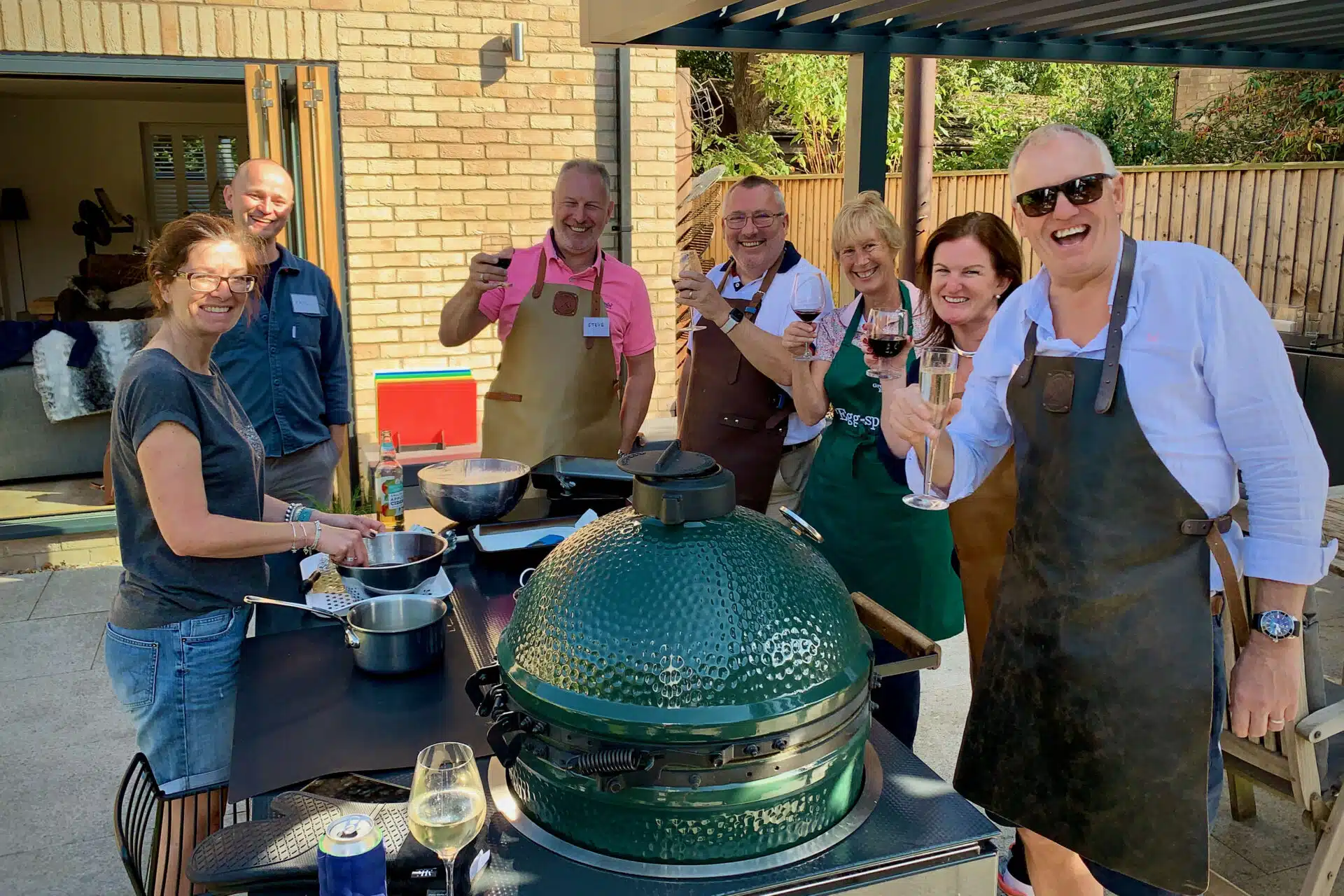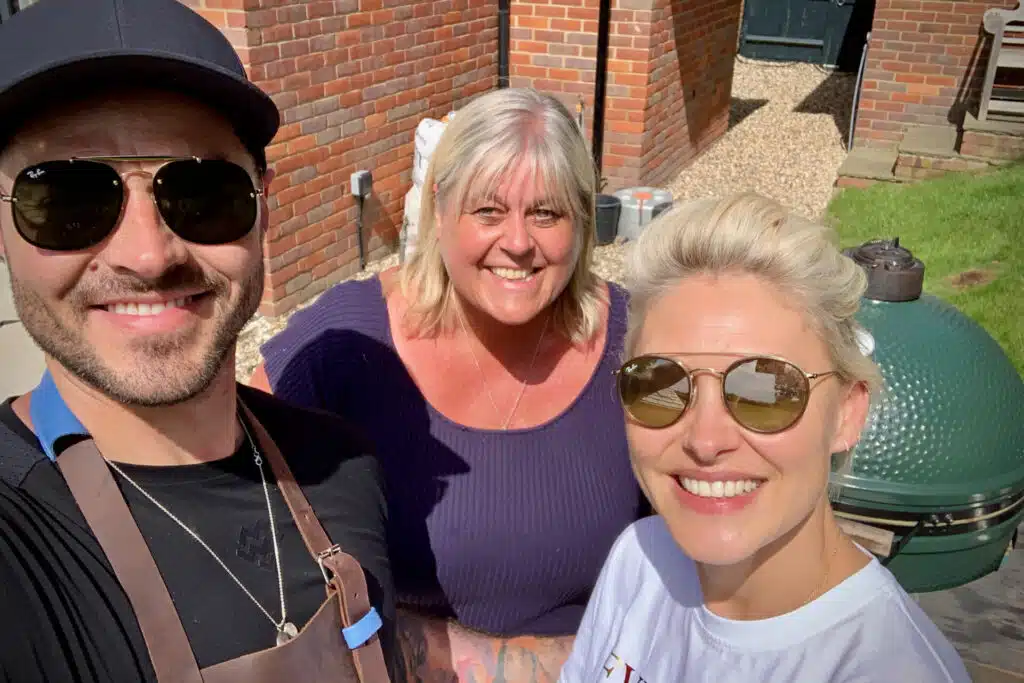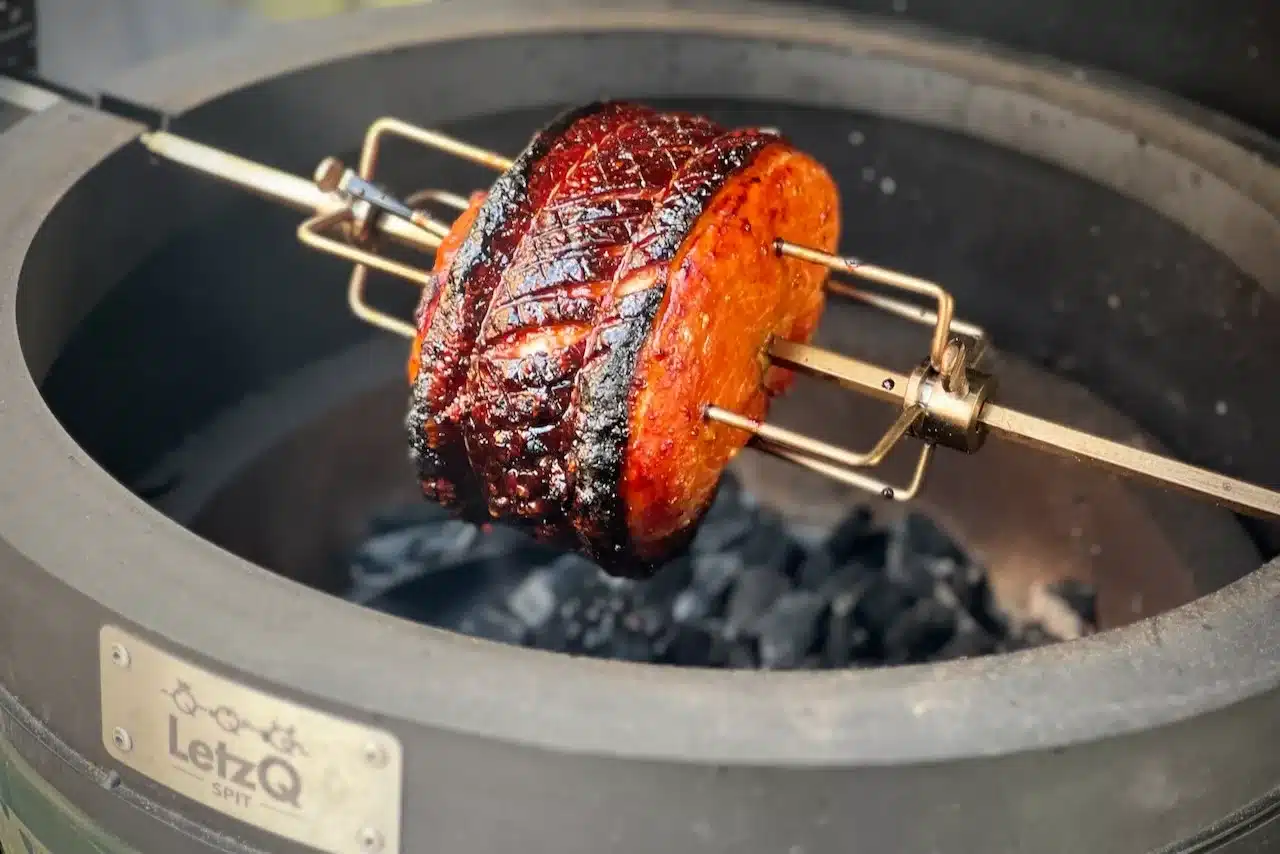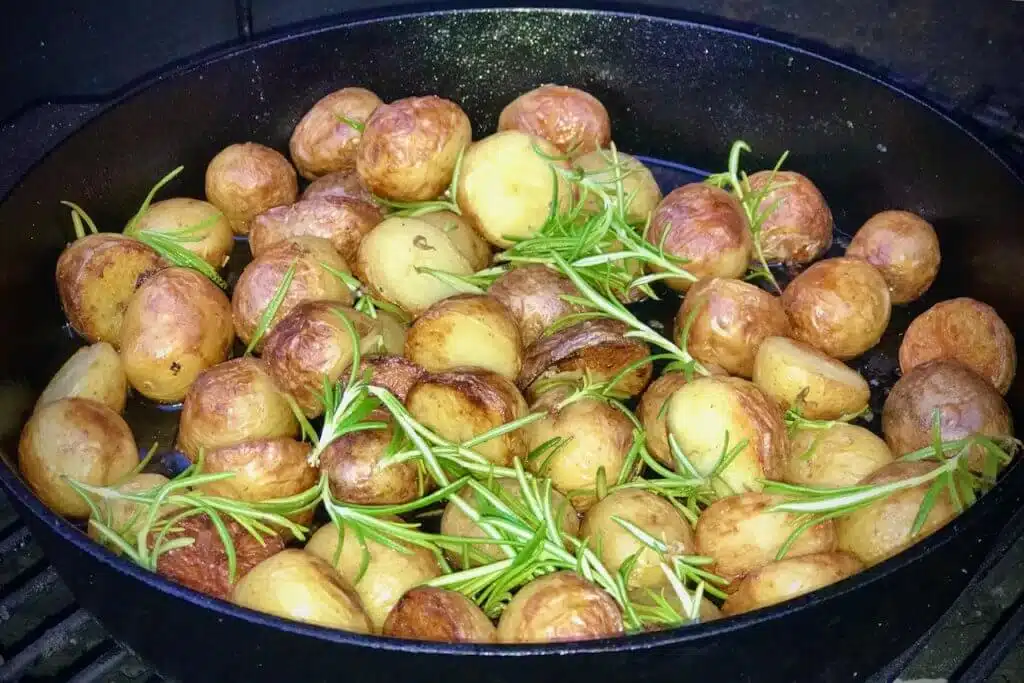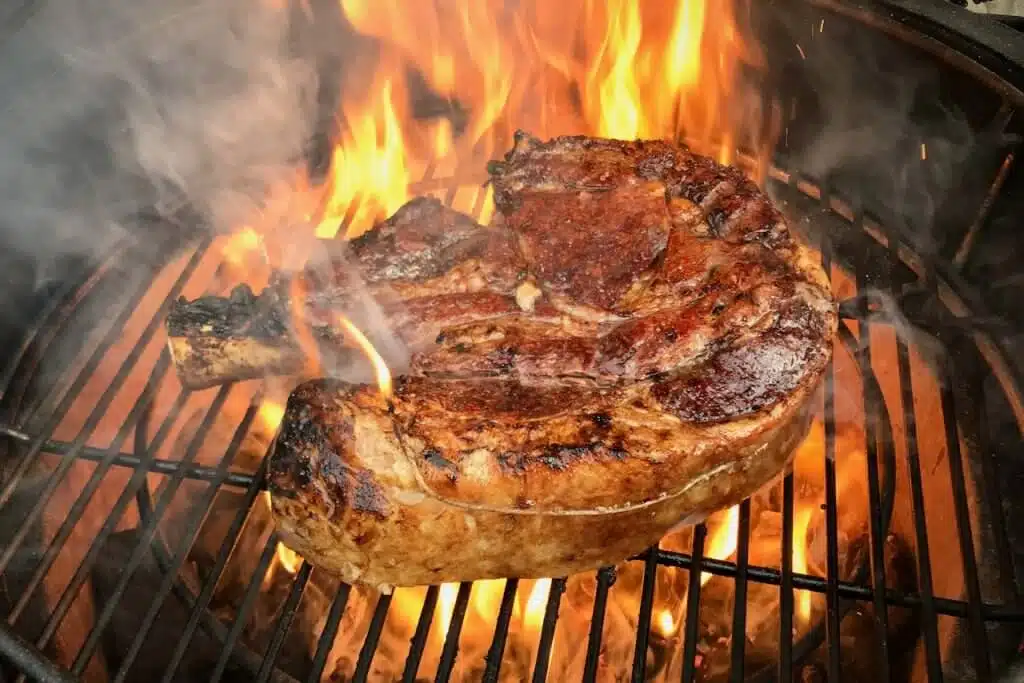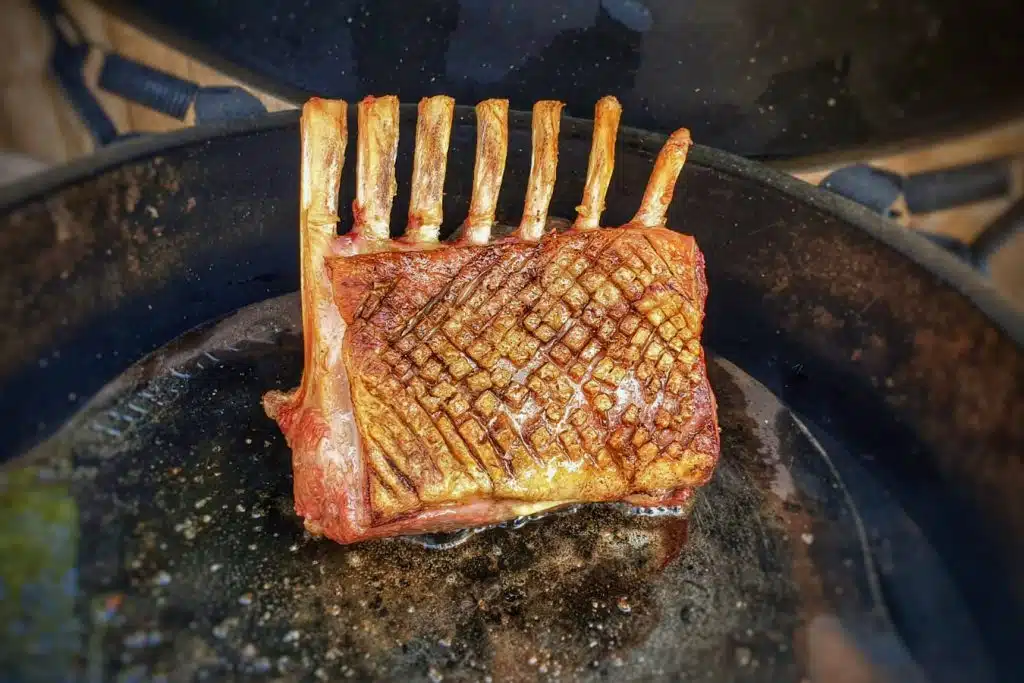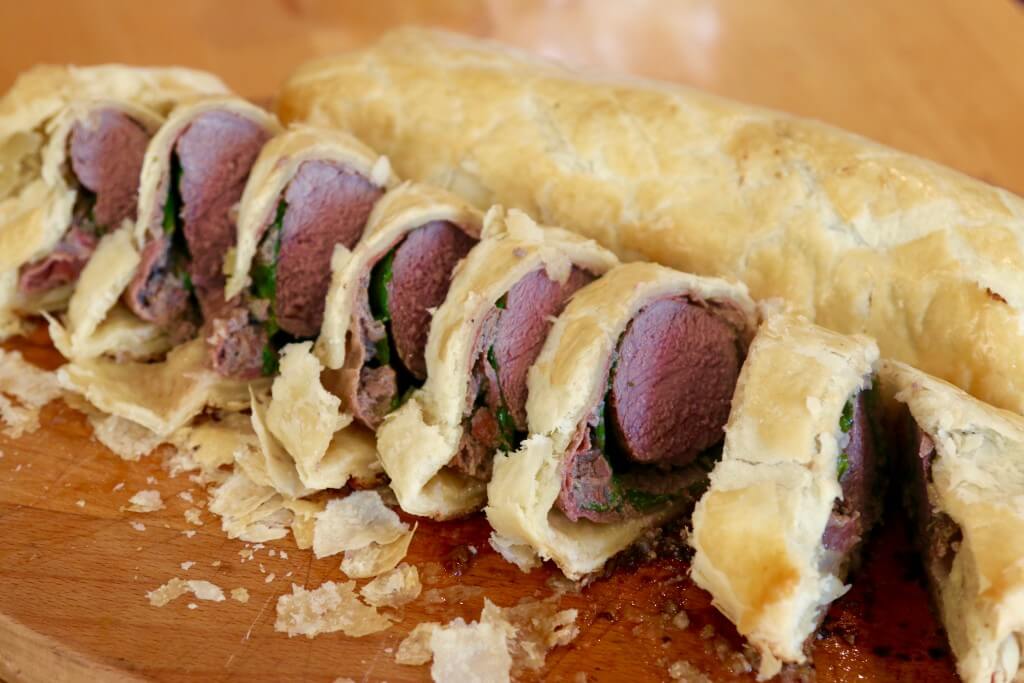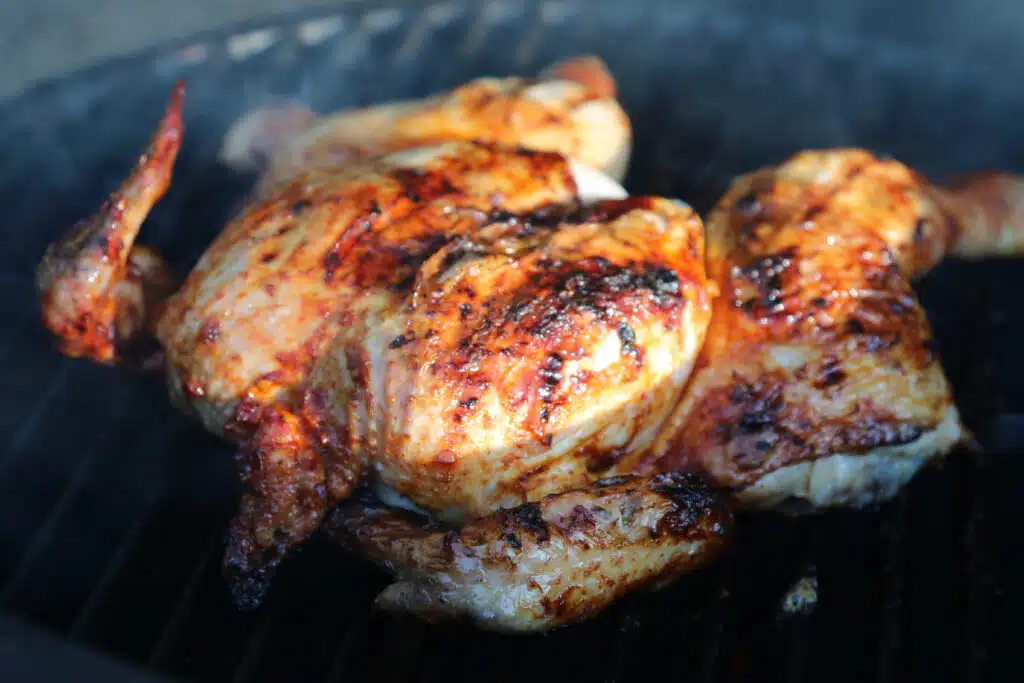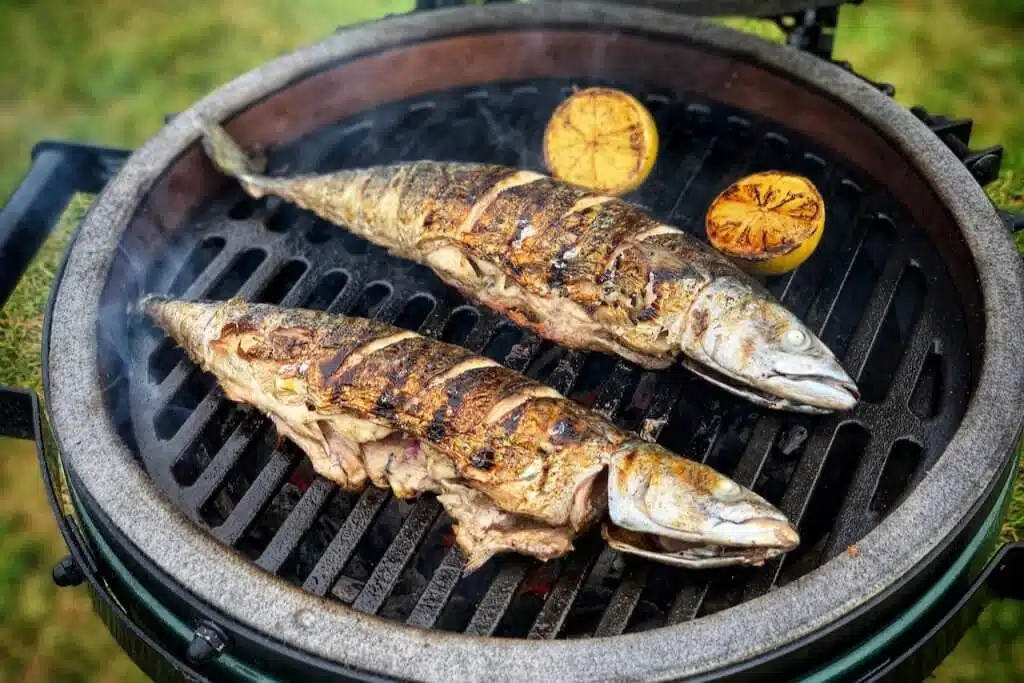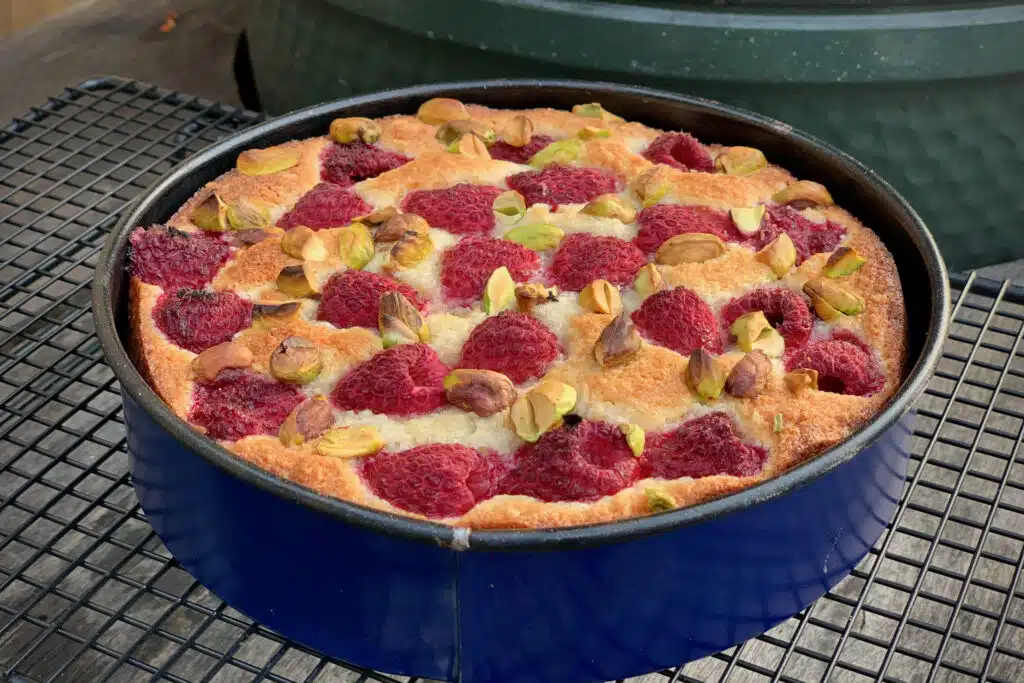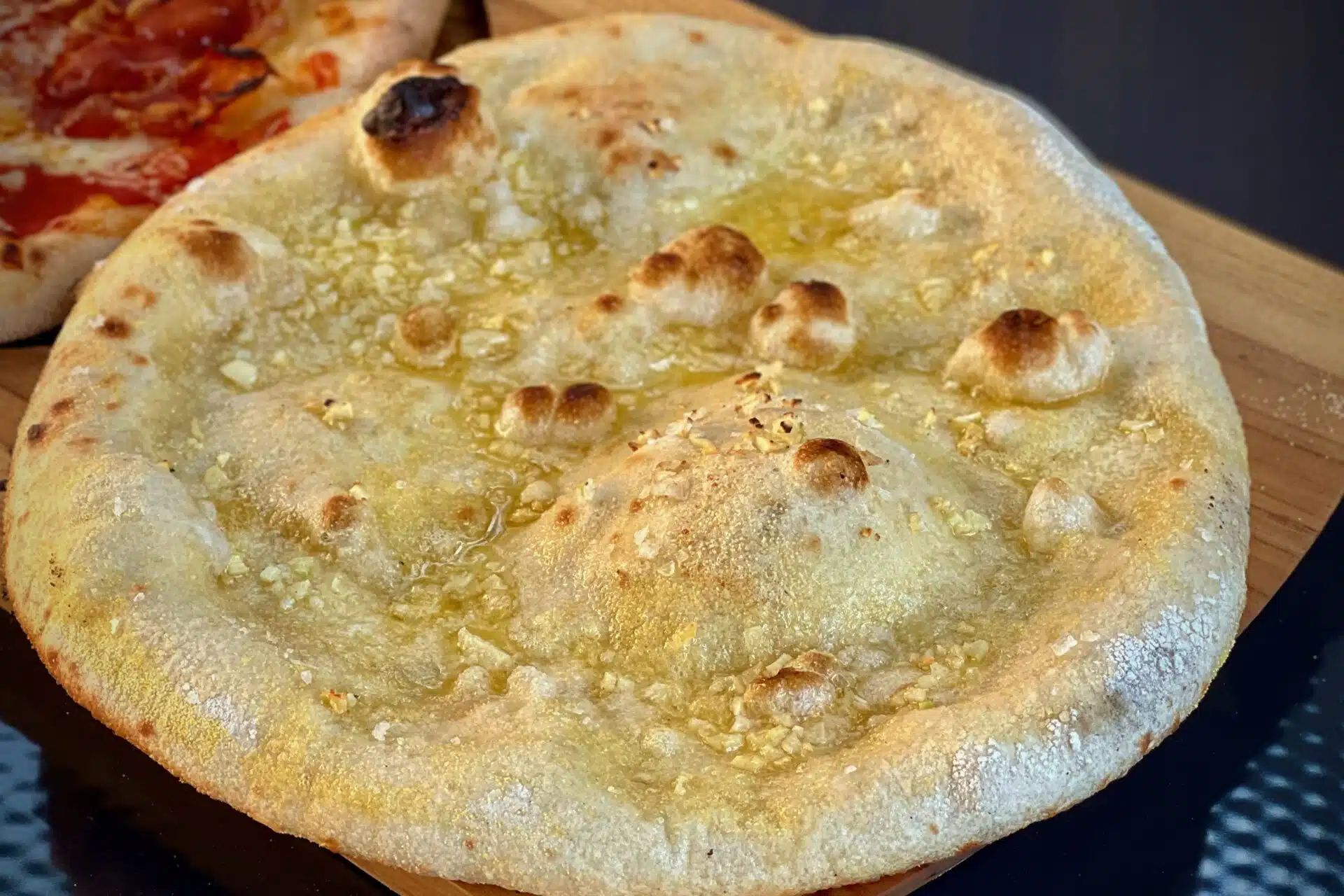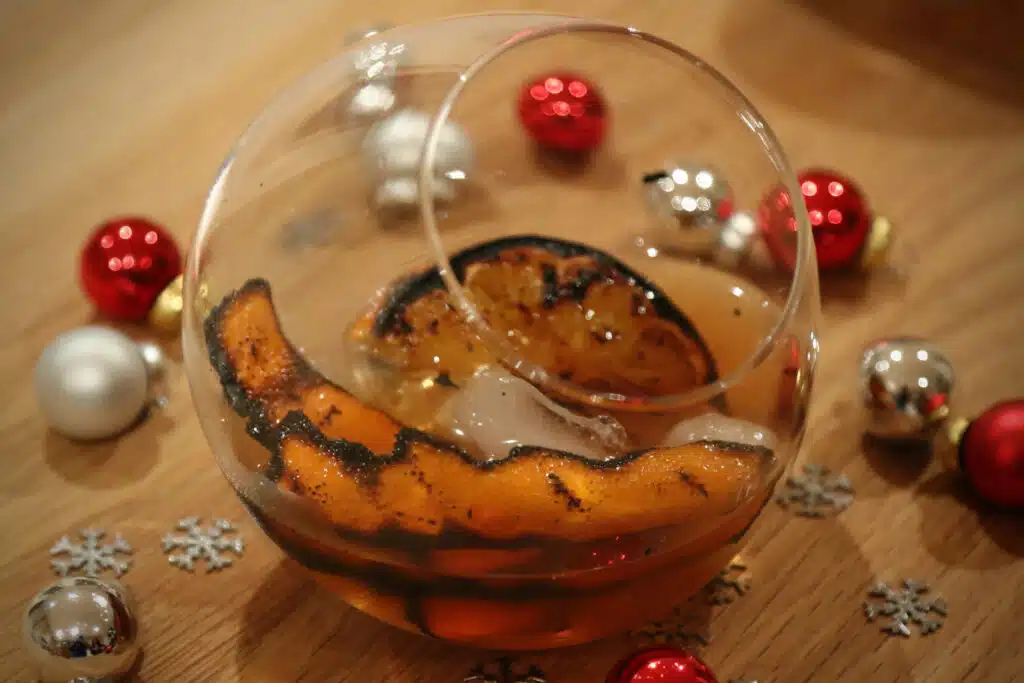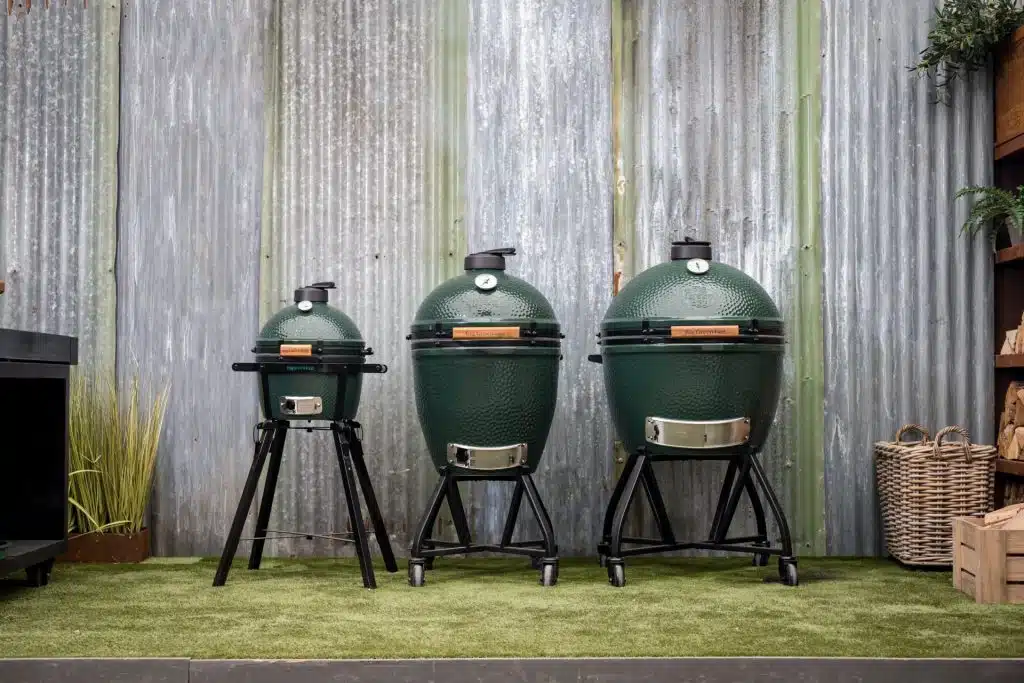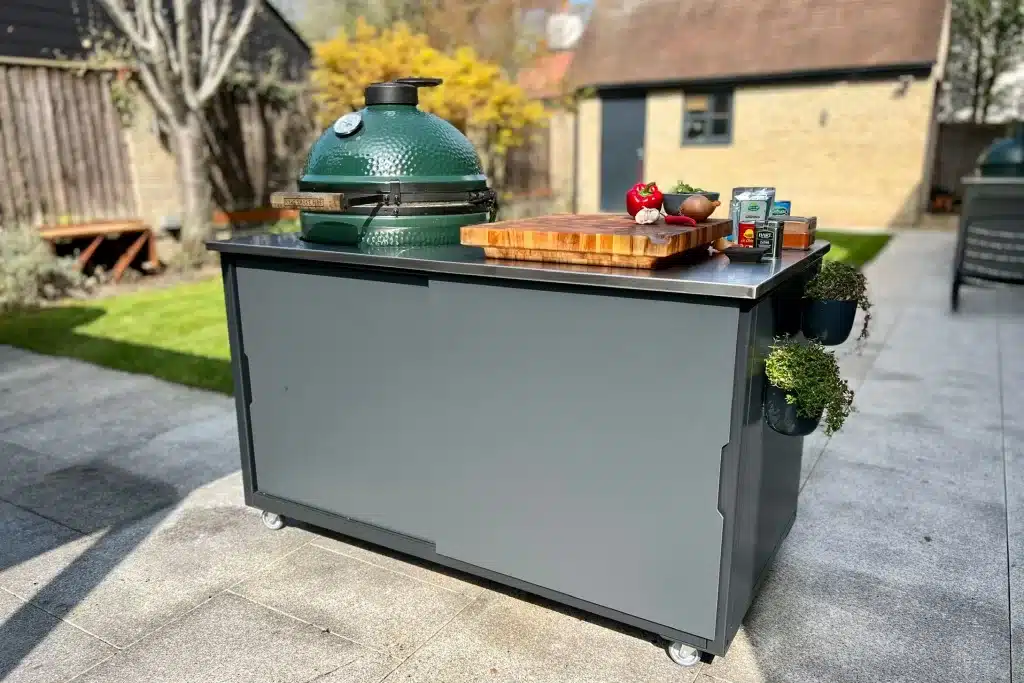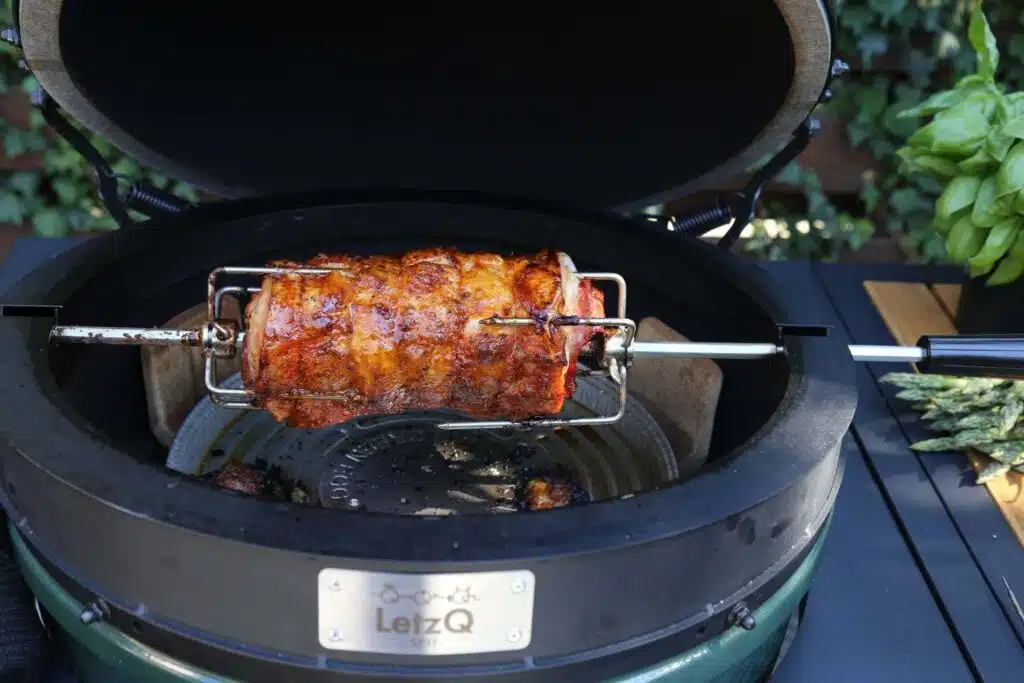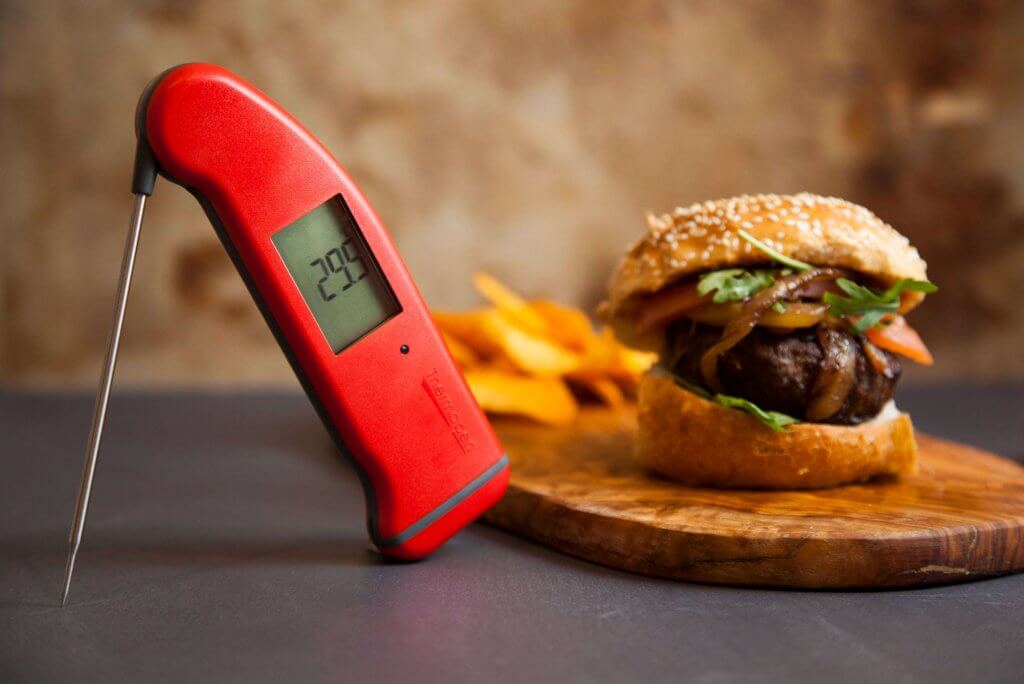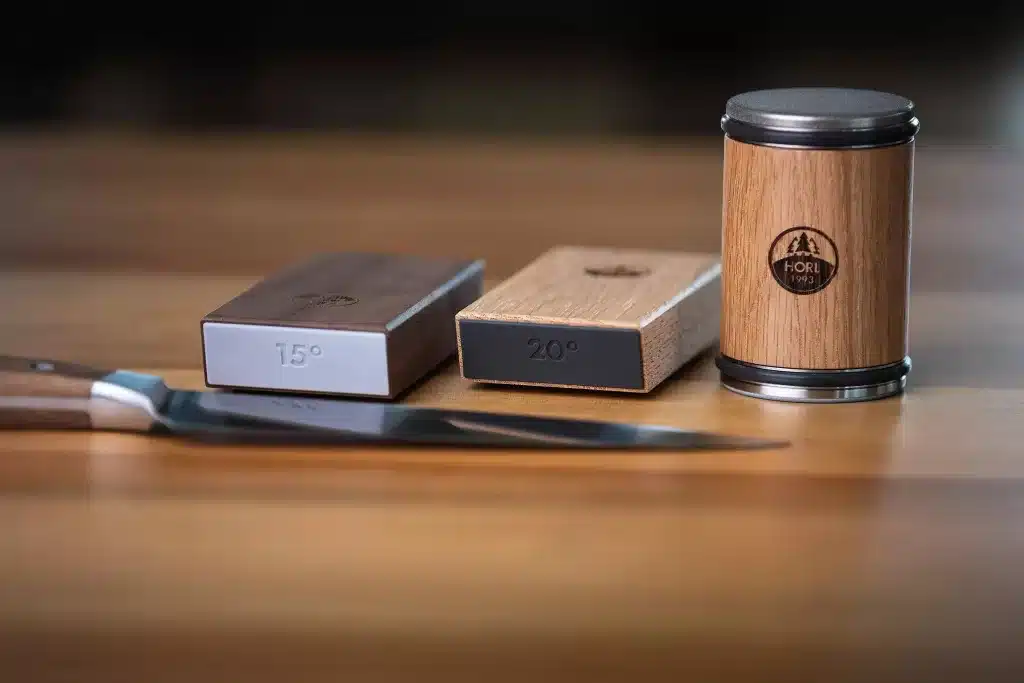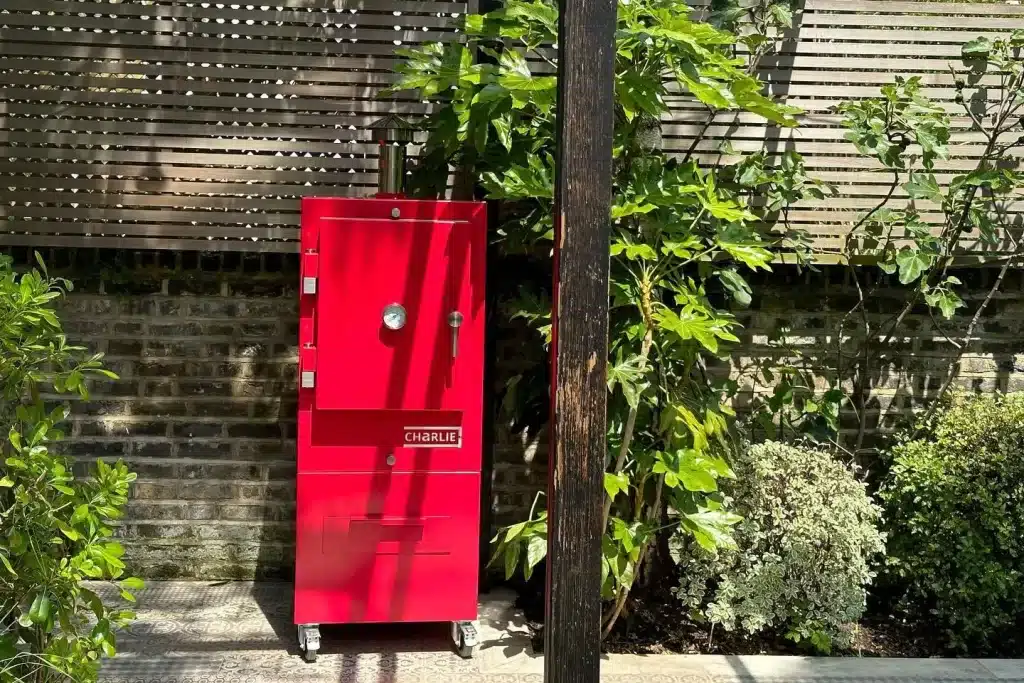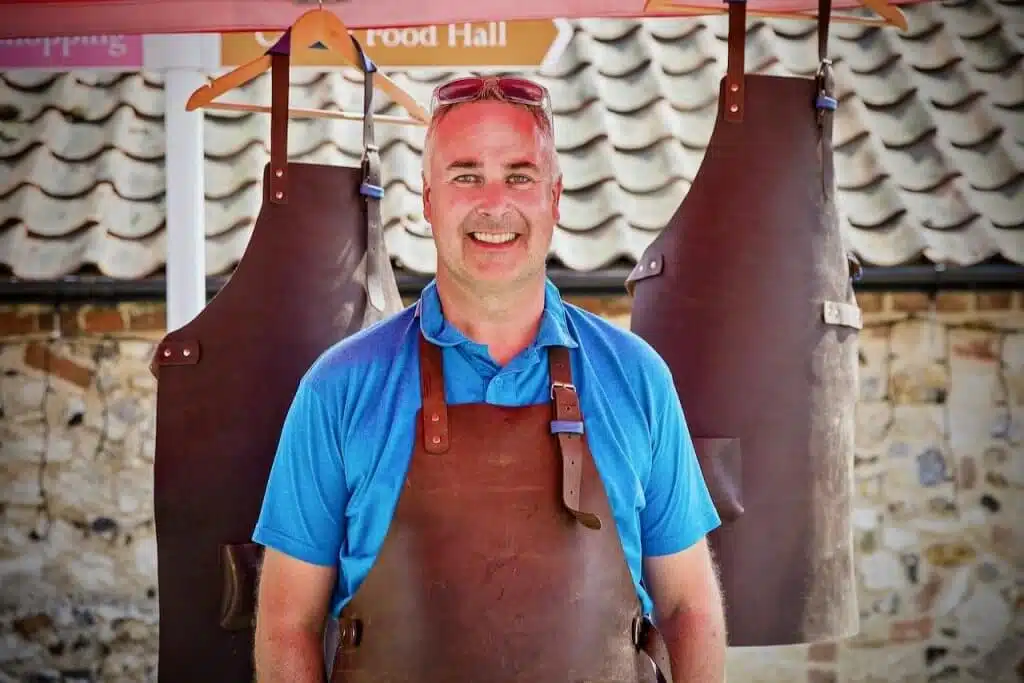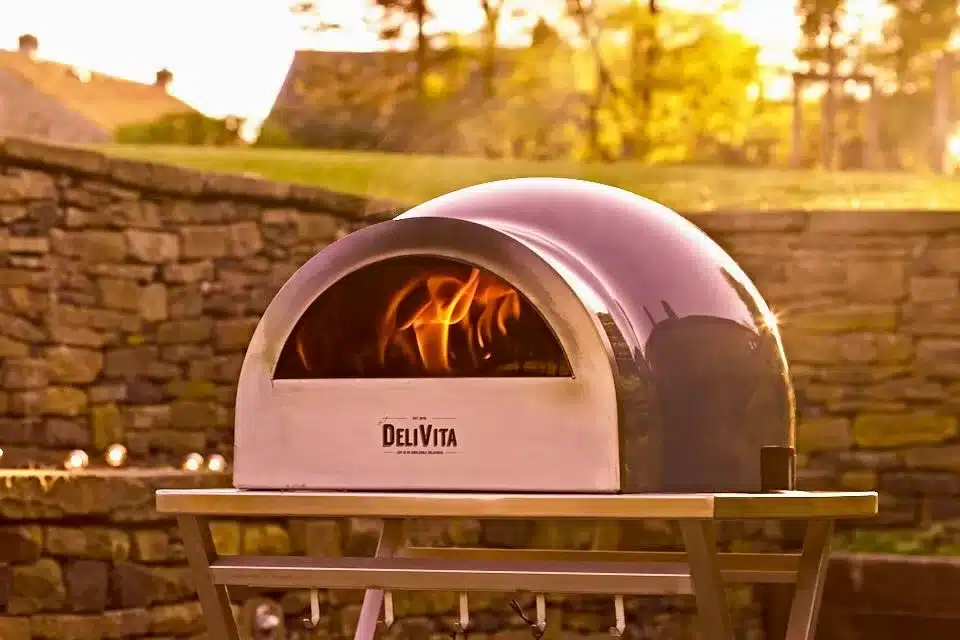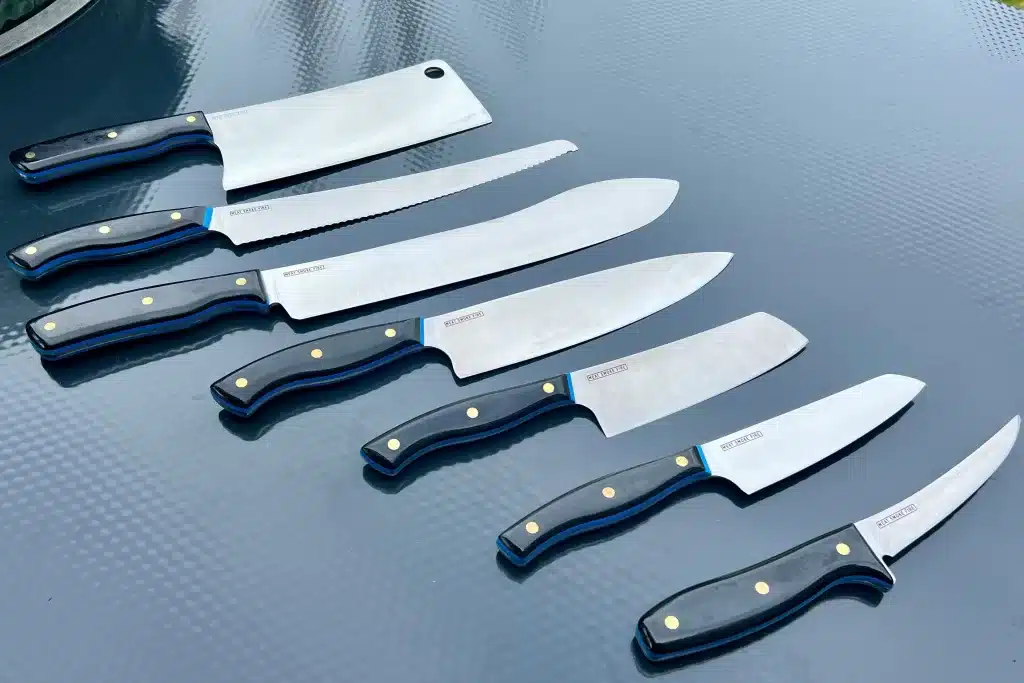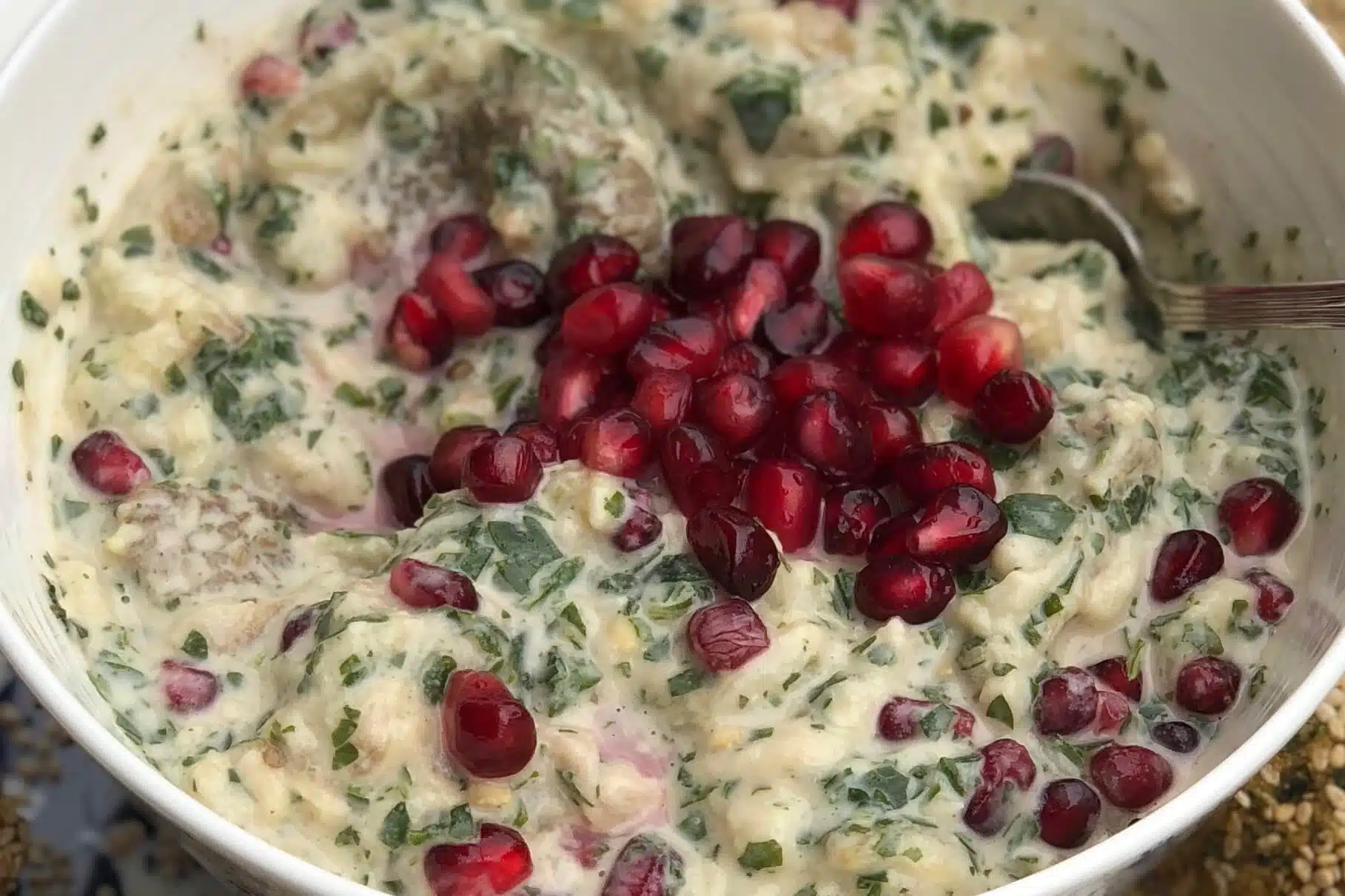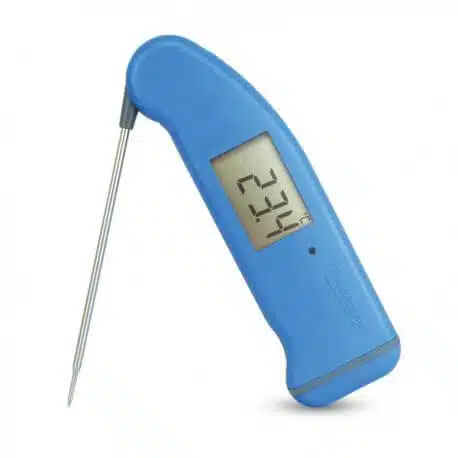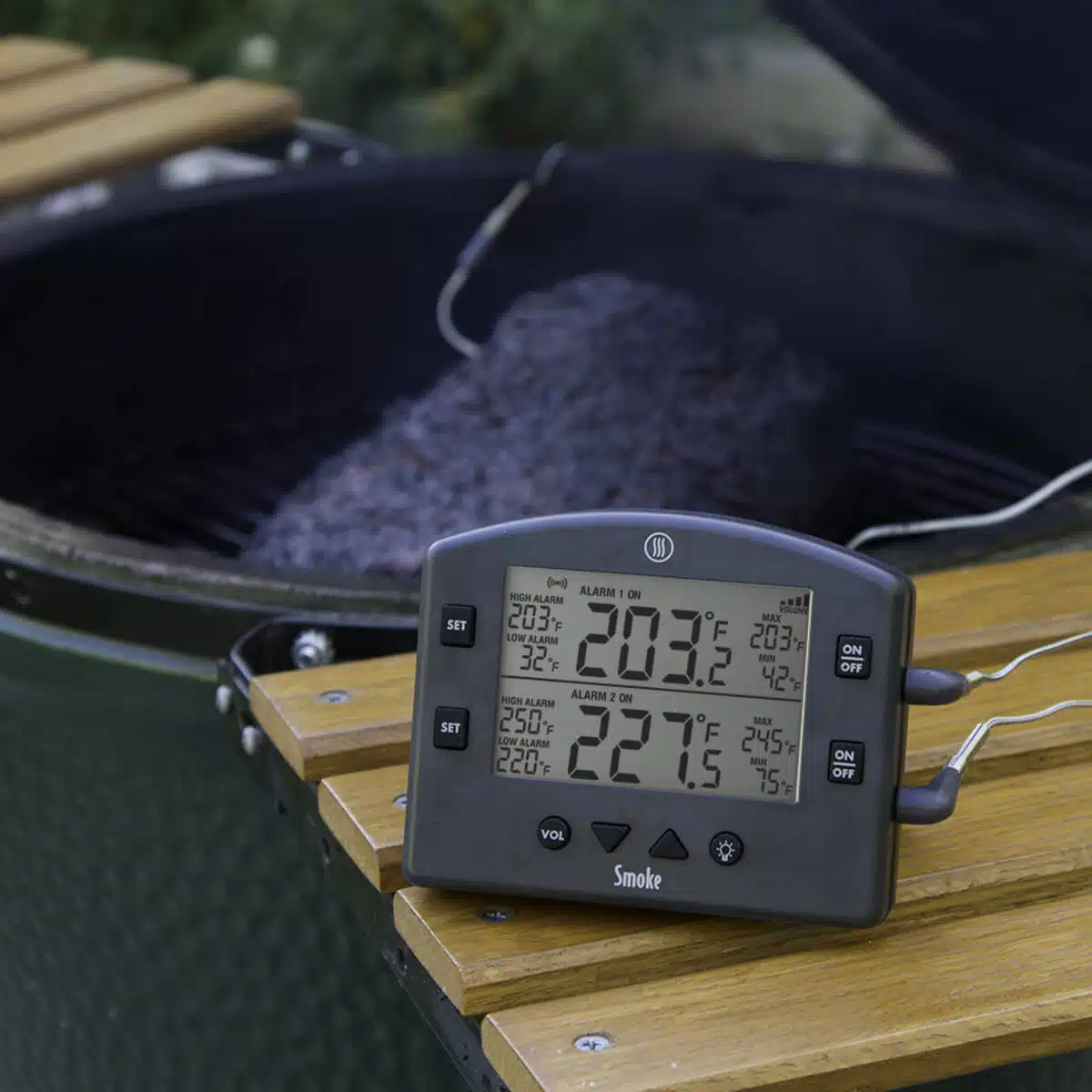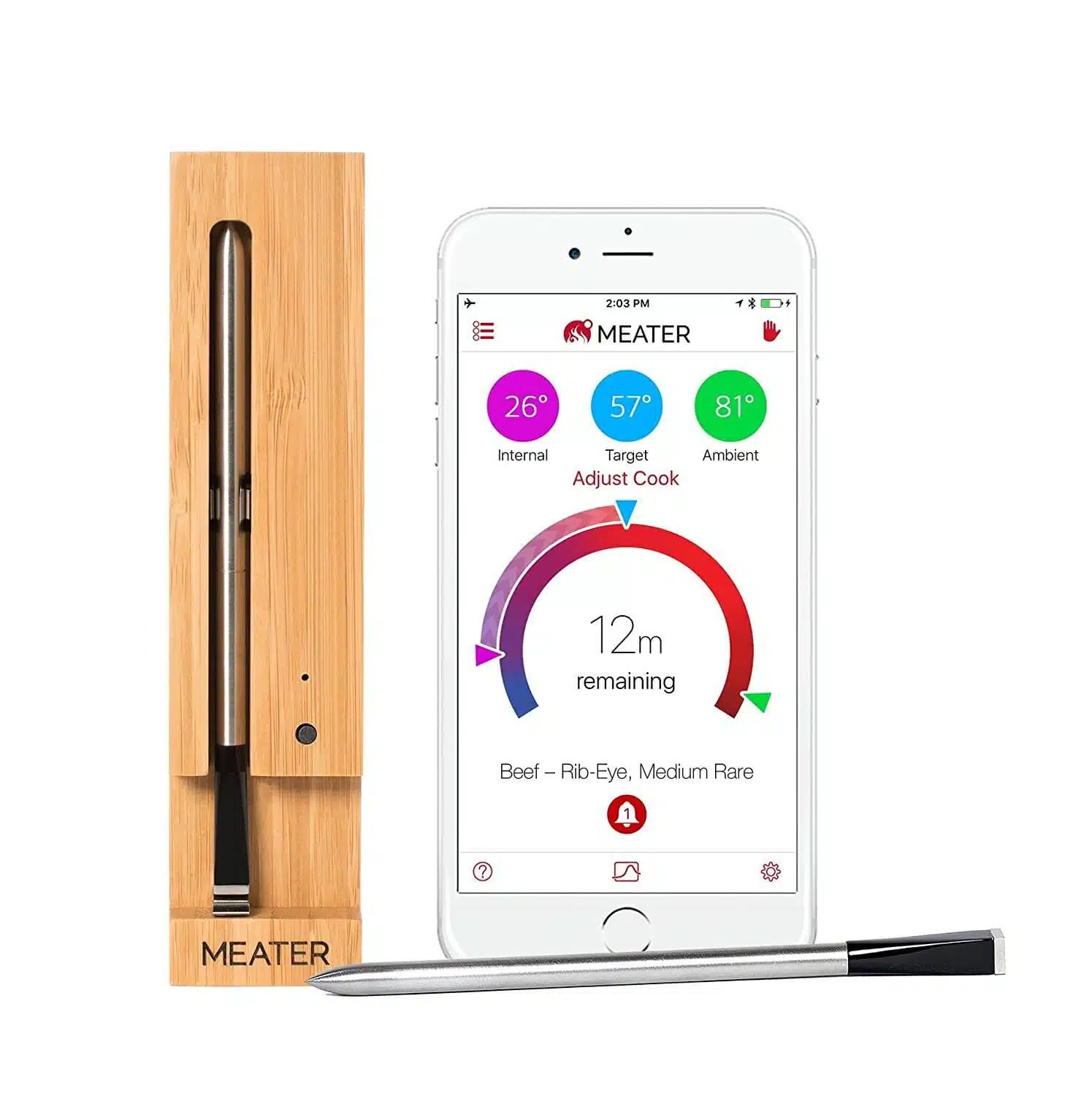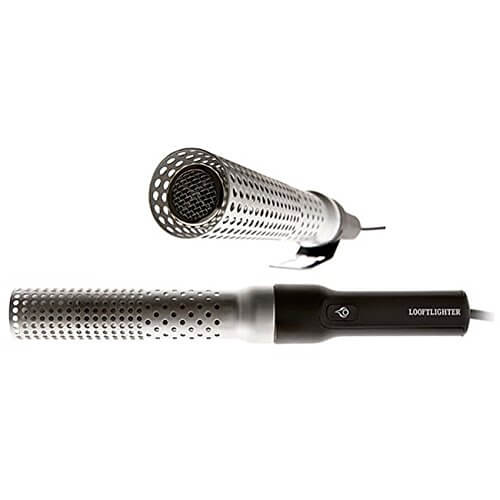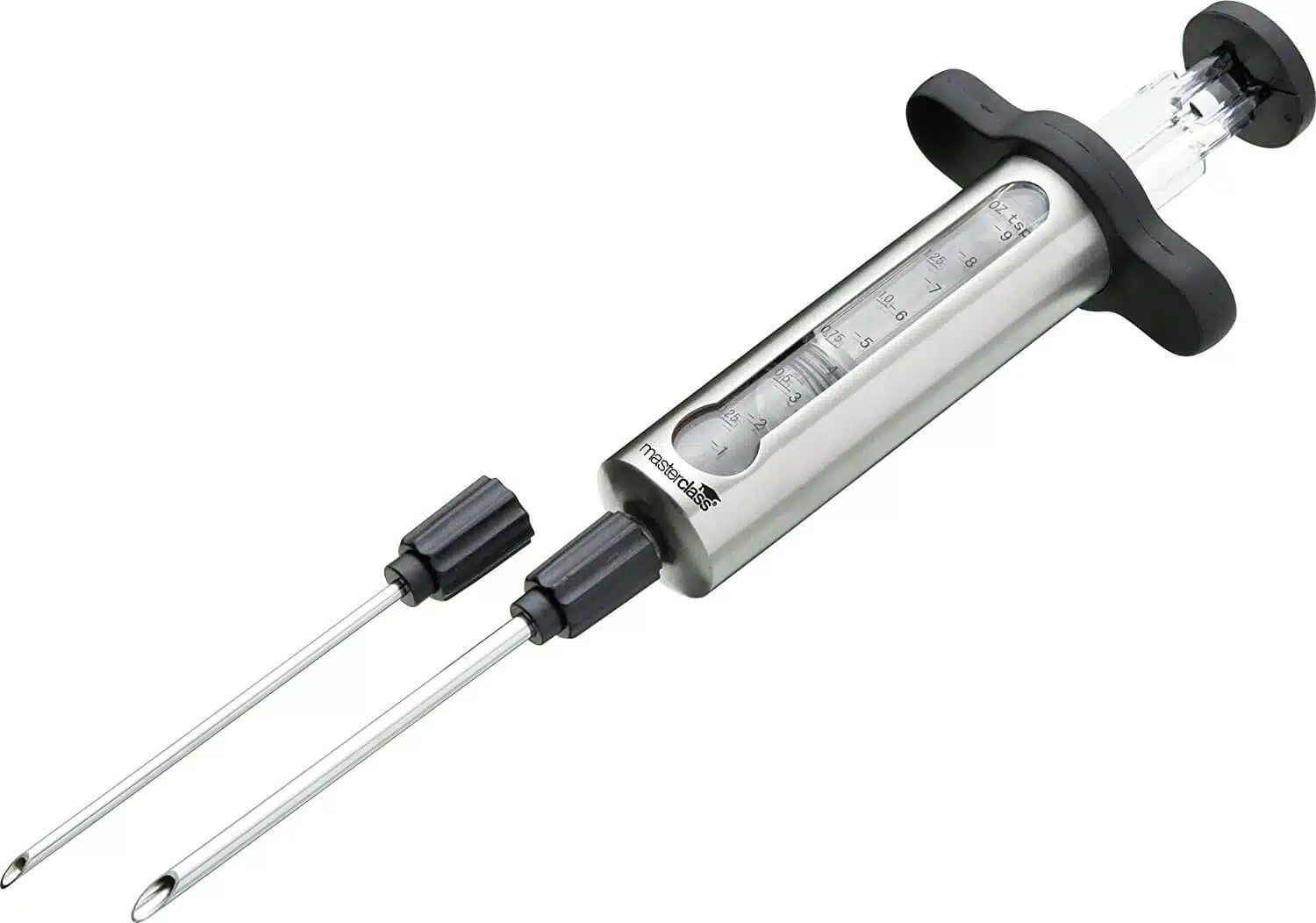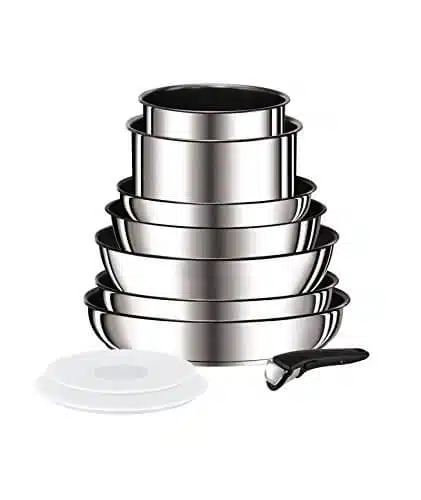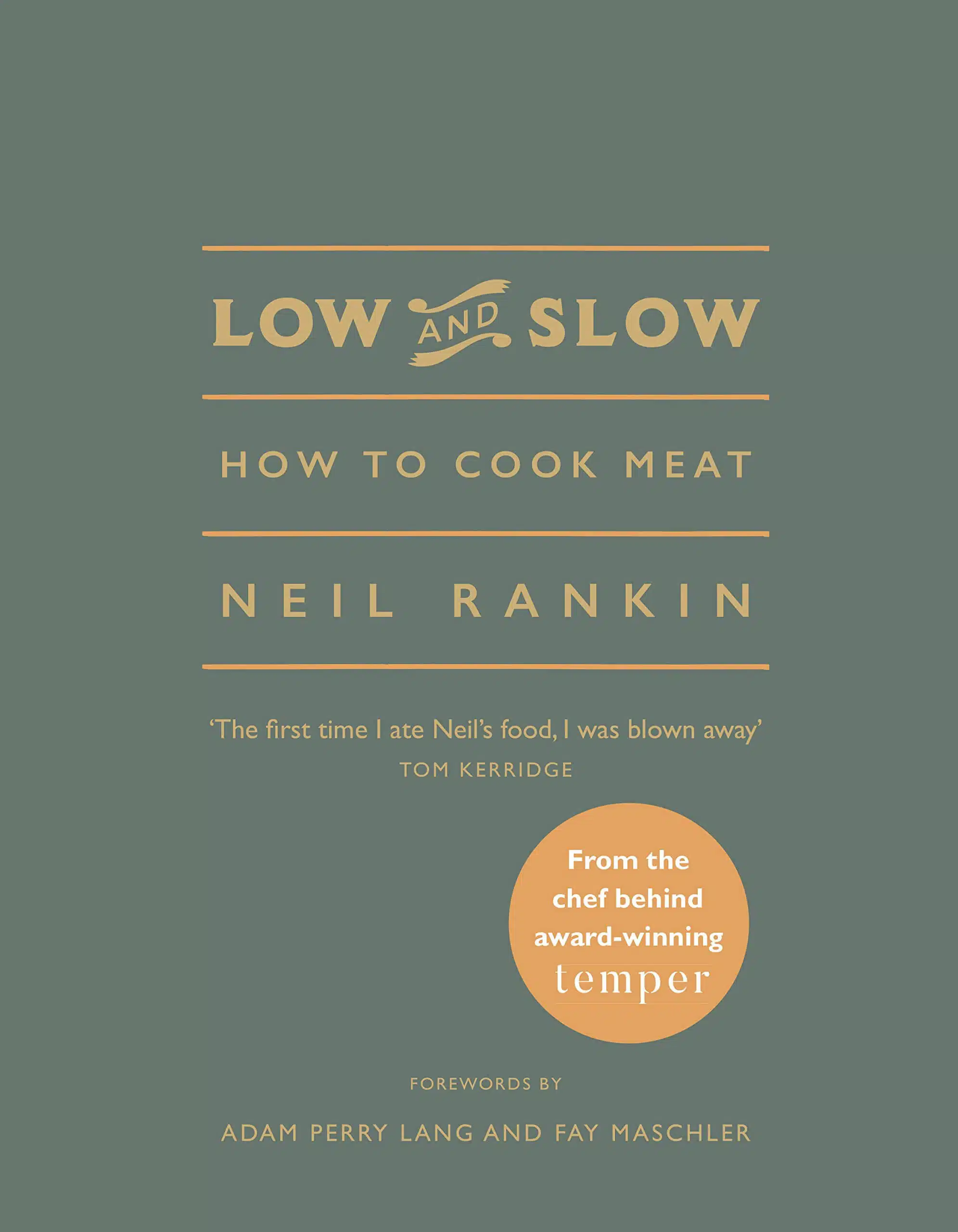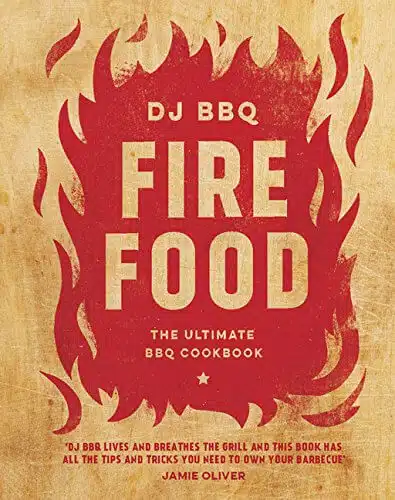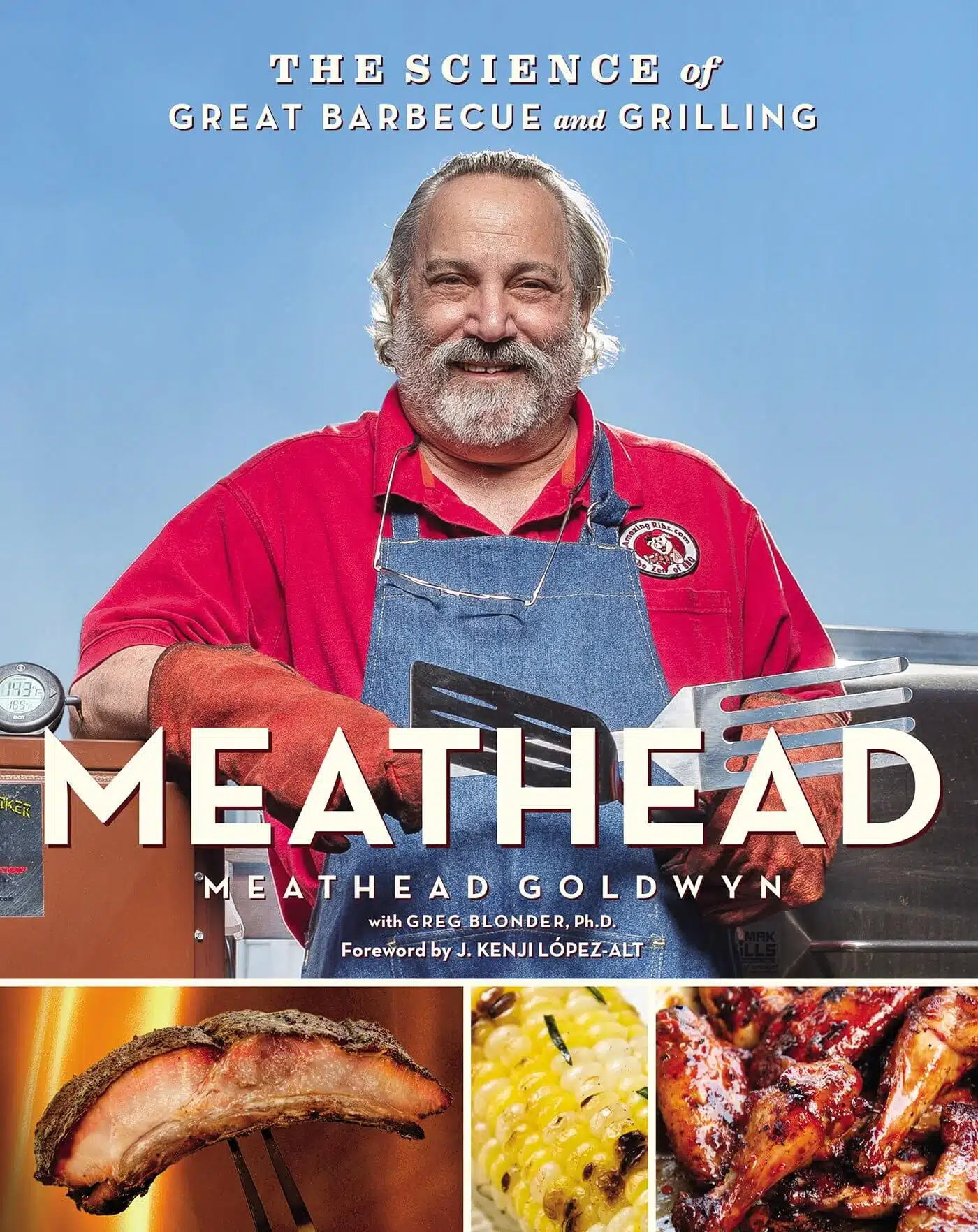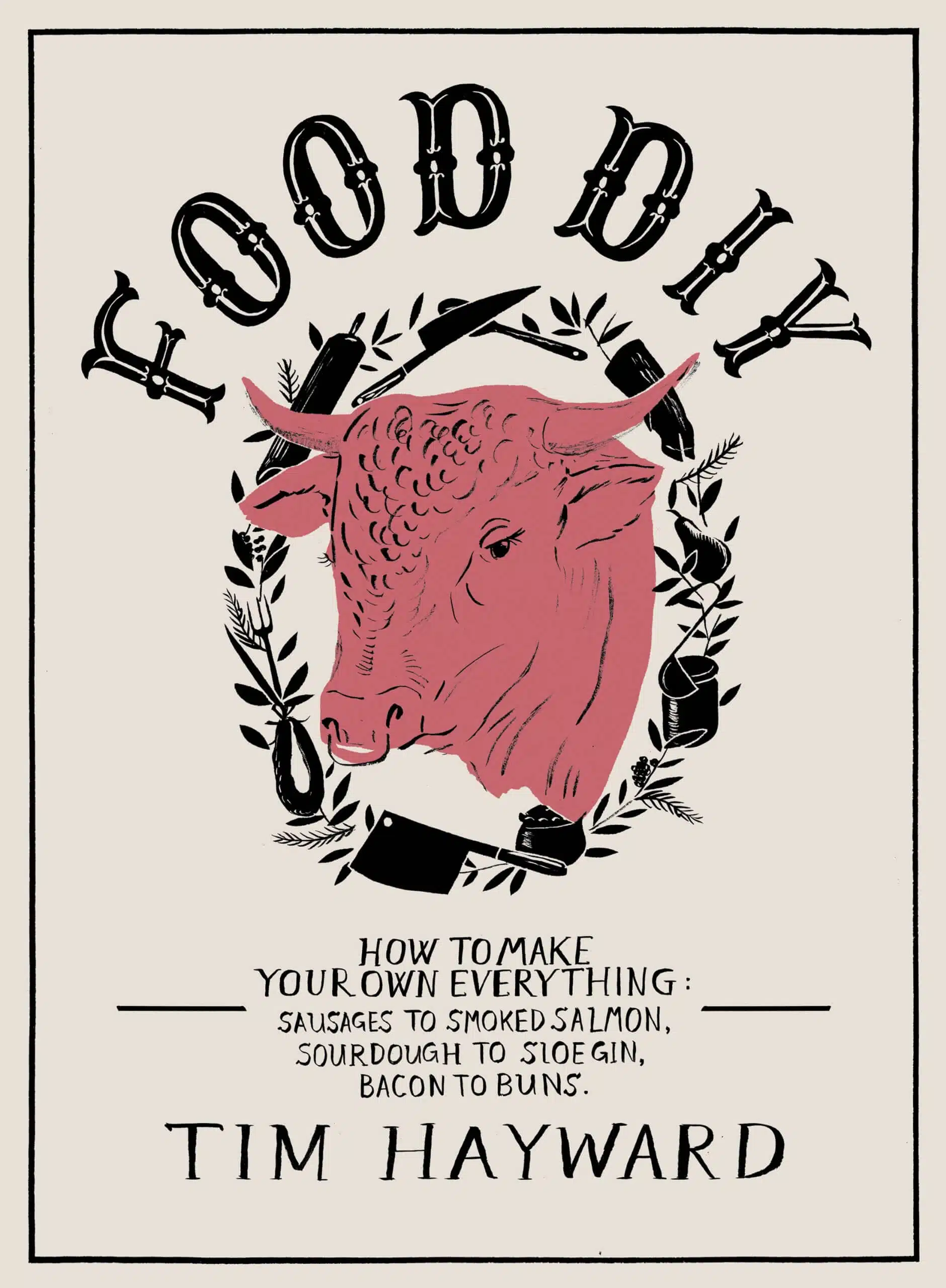


Aubergine and Tahini Dip
This lovely dip is very simple to make and can be prepared in advance of the meal and stored in the fridge. It’s topped off with burst in your mouth pomegranate seeds.
Set your Egg for a direct cook at 250°C. Make sure you pierce the skins of the aubergines before you roast them or you could end up covered in it if one explodes.
Once they’ve cooled you can scoop out the middle and mix with the other ingredients using a fork. Finally sprinkle over the pomegranate seeds.

REVERSE SEARED Rib of Beef
The technique we used here was a reverse sear where we slowly raised the temperature of the whole piece of meat by cooking it at 110°C until its internal temperature was 50°C (about 5°C below medium-rare). We then fired up the BBQ to about 250°C and seared the outside of the beef before resting it for about 15 minutes and serving in slices.
The initial cook was indirect, we used the plate setter feet up with the stainless grid on top. To that we added the meat and cooked slowly until the core temperature reached 50°C (5°C lower than the temperature we were aiming for as the last 5°C-7°C would be achieved when we seared the meat).
We then removed the plate setter and opened the air vents to raise the temp to 250°C. We used the stainless steel grid to sear the beef for about 3 minutes on each side. We then rested it for about 15 minutes before slicing and serving.

Paella
We made two paellas, one seafood but otherwise vegetarian, the second with chicken.
The first was made on the MiniMax using a Tefal Ingenio pan. We made this paella and then added the seafood about 5 minutes from the end of the cook.
The second was made in the Big Green Egg Paella pan. When cooking chicken I try and colour it before adding it to the paella. You can do this around the edge of the Egg between the pan and the Egg.
For both of these dishes I like to cook the lemon wedges as it adds lovely flavour to the dish and also makes them softer to squeeze after the cook.
I cook the paella with a direct setup using the stainless steel grid to support the pan. I set the Egg to 180°C.

Cauliflower with Black Sesame and Truffle Oil Dressing
The technique here was to cook on the back side of the plate setter. All I did was wipe down the back of the plate setter with a dry paper towel or foil.
We set up the Egg to cook at 180-200°C with the plate setter feet down.
I cut the cauliflower into about 7mm thick slices all the way through the cauliflower. I removed most of the really thick bit of stalk before cooking. I then added a touch of oil and some maldon salt to the slices (on both sides) and placed them directly onto the plate setter. We then cooked them for about 5 minutes on each side until they start to turn golden brown.
To this we added the dressing. A great addition is to sprinkle toasted black sesame seeds to give a little crunch.

French Trimmed Rack of Lamb
This is a great recipe to do with the cauliflower as it also can be cooked on the back of the plate setter (or a ceramic plancha).
Again we setup the Egg in an indirect configuration with the plate setter feet down. We set the temperature of the Egg to 180-200°C.
I scored the fat of the lamb rack in a diagonal pattern with the scoring about 3/4 cm apart. I then added a tiny bit of oil and generously seasoned the lamb with maldon salt.
I then cooked this directly on the plate setter, fat side down for about 15-18 minutes. At the last minute, we turned the lamb to add a little bit of sear to the edges.
I used a Thermapen to probe the meat. For medium rare, we were looking for an internal temp of 58°C. The lamb will continue to cook while it’s resting so take it off about 5°C before (53°C for medium rare).
Always rest your meat wrapped in foil.

Focaccia
This Italian bread is really simple to make and an easy first go at baking on the Egg.
Make a batch of my basic bread recipe and let it rise. Knock it back and split into two portions. Push out each of these dough balls into the bottom of a 30cm x 20cm baking pan, lightly oil the top and cover with cling film. Put to one side to allow it to rise again.
When ready, poke it with your fingers to make the dimples or just leave it rustic (my favourite). Drizzle generously with olive oil and sprinkle with salt and herbs (we used rosemary).
Setup your Egg for an indirect cook with the plate setter feet up, stainless steel grid on top and the baking/pizza stone on top of that. Get your Egg to 220°C and give the baking stone a while to heat up, probably 20 mins..
Cook your focaccia in the tin on the baking stone for about 15 minutes until it’s both golden brown on the top, but also crunchy on the bottom. Allow it to cool on a wire rack before serving.
Dirty Carrots
This is a recipe I have stolen from DJ BBQ (Christian Stevenson). His new book Fire Food is well worth getting with some great recipes in there.
In the past I have modified this recipe a little as when I first made it I didn’t have any maple syrup but did have honey. The downside to this, and I learnt the hard way, is that honey burns more easily than maple syrup..
Anyway the recipe is to cook similar sized carrots on the coals with your Egg at 180°C. Turn the carrots every few minutes until they start to bend. Now take them off the Egg and add your stainless grid and a frying pan.
Into the frying pan, add a teaspoon of cumin seeds, the carrots cut into 1 inch ling chunks, 2 tablespoons of balsamic vinegar and 2 tablespoons of maple syrup (or honey, but be careful).
Heat this for about 8 minutes but be careful not to burn it!

Grilled Sea Bream
We cooked the grilled sea bream on the wider bars of the cast iron grid. The Egg was set to 200°C in order to crisp up the skin.
The cast iron grid supports the bream well. It give the fish some great colour while remaining non stick if you wipe it with a little oil before the cook. I also apply a little oil to the skin of the fish.
When cooking the fish we’re looking to turn the opaque flesh to a lovely white colour.
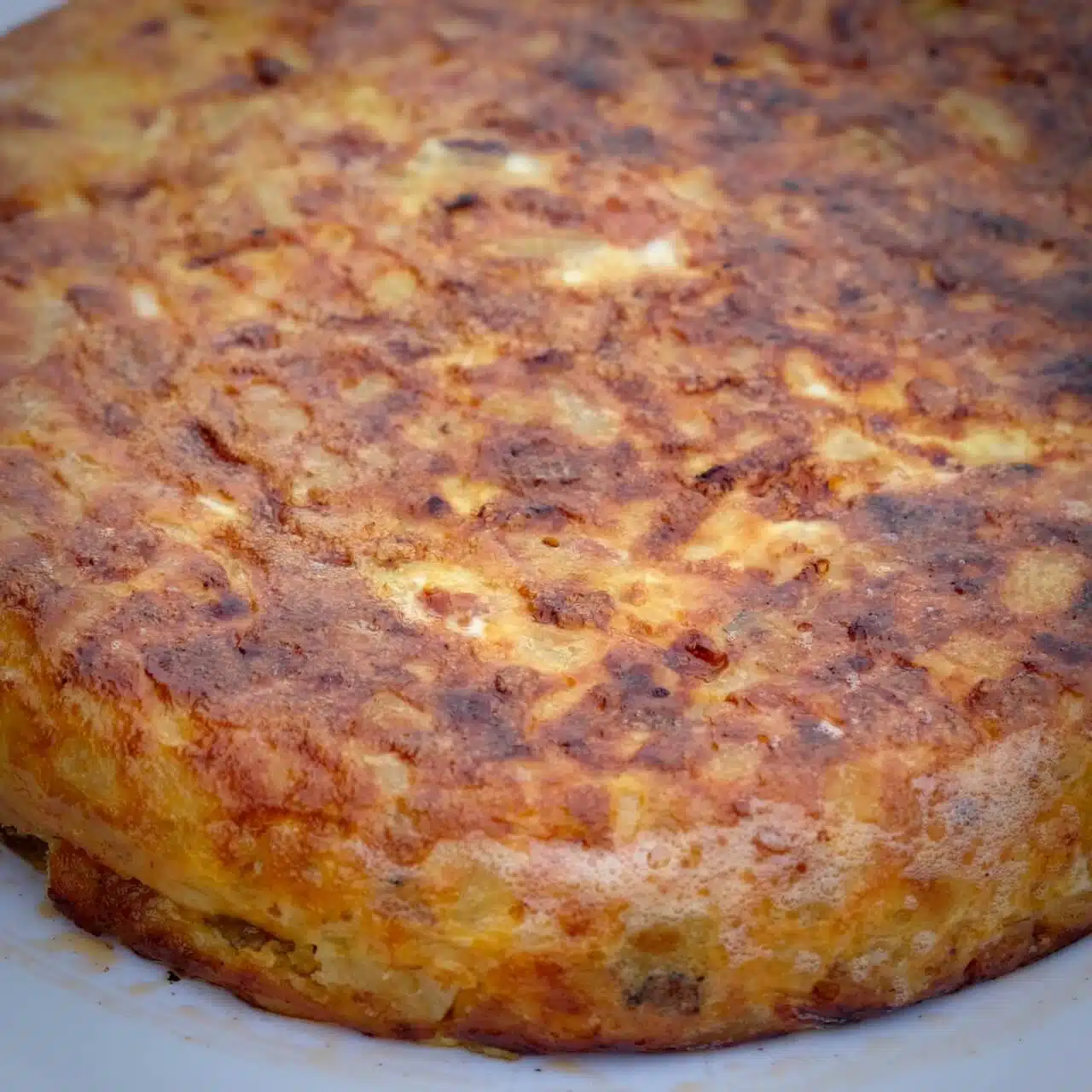
Spanish Tortilla
Tortilla is a staple dish in Spain and served as tapas everywhere. I personally love it but I also like to spice it up a little.
We made a standard tortilla with just potatoes, onions, eggs, oil and seasoning. I like to add spicy chorizo that I fry before hand to crisp up.
I setup the Egg at 180°C and cook the tortilla directly over the coals on the stainless grid. I use the Tefal Ingenio pans to cook this in.
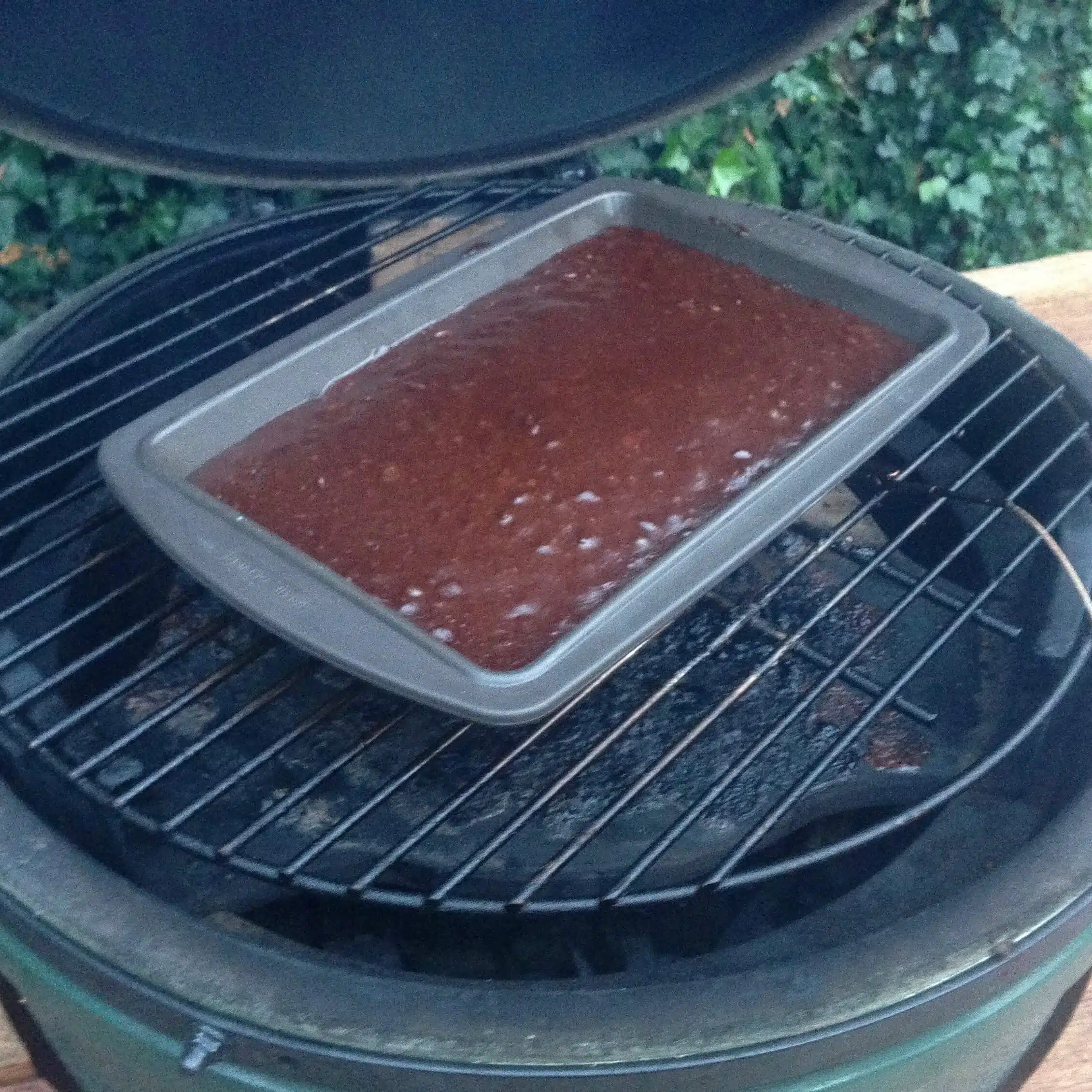
Smoked Chocolate Brownie
Helena knocked up a lovely chocolate brownie. We baked it in my silicone baking tray for about 35 minutes at 160°C using an indirect setup with a baking stone (or MiniMax plate setter in this case).
I used a little pecan wood chips to give a subtle some hint.
I normally cook until the middle just has a slight wobble left in it when you shake the baking tray.
Cool it on a rack before serving.
Technique and Questions
How do I light my Egg?
- Top up the Egg with new charcoal to just above the line where the fire bowl and the fire ring meet.
- Create a small indentation in the centre of the charcoal and put in just one lit fire starter.
- Cover very loosely the fire starter with a few pieces of charcoal, you need to allow a good airflow.
- Leave the lid open and open the bottom draft door. Leave your Egg for 10 minutes to allow the middle of the charcoal to get going.
- After 10 minutes, close the Egg lid and open the cast iron top fully. Remember to position the screw towards you.
- Leave the Egg closed for about 5 minutes until it hits 180°C and has started warming the dome.
- You can now adjust your Egg to the temperature you want to cook at. See my temperature guide.
Do take a look at the Big Green Egg Tips Series. This video covers lighting your Egg,
What temperature should I cook at?

Cooking temp guide from AmazingRibs.com
What settings are needed for specific temperatures?
THE BEST WAY TO SCORE PORK FAT
Always cut away from you. You might find it easier to cut from the centre of the skin to the edge. You can then turn the pork 180° and then score from the middle to the opposite edge.
wHICH CHARCOAL SHOULD I USE?
The Green Olive Firewood Company do charcoal that has a much milder smokey flavour, It’s made from SheOak. You need their restaurant grade lump wood charcoal.
Stag Charcoal also produce some great stuff in Hertfordshire. Look for their single species Ash or Birch for a less smokey cook.
When you really get into BBQ then look at some of the excellent charcoal from the Oxford Charcoal company. They have a very good reputation for their single species charcoals. They have a great chart on matching wood to meats and fish.
How do I use Chips and Chunks of wood?
Meat takes on smoke much better when it is cool and wet. Therefore you want to be generating smoke at the beginning of your cook. Since the charcoal in your Egg will be burning from the middle outwards, you need to place the smoking chips or chunks towards to middle of your Egg.
You don’t need too much wood to smoke with. I therefore recommend you just use a small handful for your first cooks and then build up on future cooks until you find the right level that works for you with that particular dish.
How do I cook Ribs?
- 3 hours indirect
- 2 hours indirect but wrapped in foil with a small spritz of apple juice (1 tbsp per pack)
- 1 hour indirect
During the last 30 minutes you can then apply BBQ sauce.
The rack of ribs should bend when they are cooked but not fall apart. The meat should pull from the bone but not fall off the bone.
If you’re cooking baby back ribs (the much smaller ones) you might want to reduce the timing to 2-1.5-1.
Try some of the rubs from Angus and Oink, their Sweet Bones and Butts rub mixed with their Porky White Chick is a great combo for ribs.
When should I use Pepper?
I recommend you apply pepper to your cooks only if they are indirect.
Using Marinades and Sauces?
Try and avoid tomato based sauces for hot and fast cooks as the sugars in the tomatoes will burn easily. I therefore apply BBQ sauces which tend to be tomato based at the very end of a cook to avoid over cooking them. Any marinated meats from a butcher will likely have tomato on and therefore burn easily.
CURED MEATS AND THE PRO Q COLD SMOKE GENERATOR
This will allow you to smoke meats for up to 10 hours per fill. You can use different wood dusts and I find the ones from HotSmoked.co.uk to be the best. You can even try discount code MP10 to get 10% off.
To cure salmon I use a 50/50 mix of sugar and salt for between 4 and 6 hours on the salmon. The recipe is here.
To get into curing meats there are a number of books. I started after reading Tim Haywards book, Food DIY.
HotSmoaked.co.uk also sell bacon cures. Making your own bacon is really easy, give it a go.
Making the best baked potatoes
The Stall or Plateau explained
The best resource on this is at AmazingRibs.com. Give it and the other articles a read. It’s a superb site.
Rest your meat
There is a great article discussing whether this is a myth but I still like to rest my meat: http://amazingribs.com/tips_and_technique/mythbusting_resting_meat.html
Reverse Sear
Using Planks Multiple Times
- Lemon and lime – lovely citrus flavours go well with fish
- Beer, cider or lager
Now instead of using the planks directly over the charcoal, use your ConvEGGtor (plate setter) feet up with the stainless steel grid and place the planks onto the stainless grid. You’ll still get the wood flavouring but it won’t burn your planks away.
Remember always place your planks on to a heat resistant surface when you take them off the Egg.
Using a cool box to rest meat
Once your meat is cooked, wrap it in several layers of aluminium foil and place it into your cool box. Then cover with bath towels and shut the lid. Make sure you use old towels as you’ll never get the smell of BBQ out of them!
Cleaning your Egg
Clean the ash from your Egg every five or so cooks. Use the ash tool to do this.
Every 12-15 cooks take the whole of the inside of your Egg out and brush down with the dustpan and brush. Some people hoover out their Eggs but if you do this make sure it is cold, I had a customer set her Henry on fire.
Rust on your Egg cast iron cap and searing grid
You’ll need to repeat this process a couple of times a year.
Great video resources on cleaning and using your Egg
Equipment
Leather Apron
I’ve had these lovely leather aprons designed and made in my village. They have the Thermapen pocket on them which is branded with my Meat Smoke Fire logo.
The leather is Crazy Horse waxed leather. A saddle wax will restore it to it’s original state or you can let it get naturally weathered like mine.
They’re in my own online shop here.
Probe Thermometer
Every BBQ chef should have a Thermapen 4. It’s by far the best probe thermometer on the market. It’s super accurate, fast reading and waterproof and has a backlit screen for use when it’s not so bright outside.
You can buy it in my shop and I have set you up with a discount code to use at the checkout, CLASS10.
Wireless Thermometers
Thermoworks who make the Thermapen, have launched the Thermoworks Smoke in the UK. This is the best wireless thermometer in my opinion, it’s so easy to use and has super accurate probes. It’s not a replacment for a handheld probe thermometer like the Thermapen you already have but it does allow you to monitor cooks from the comfort of an armchair.
This was the device I used for the reverse seared picanha.
Bluetooth Thermometers
The Meater is a lovely piece of kit. It’s not quite as accurate as the other two thermometers but it does give a great guide and then you can use your Thermapen to check the cook, something I would always do anyway even when using the Thermoworks Smoke.
We saw that there was some temperature variance across the picanha we cooked, so it’s always worth probing with a Thermapen to check.
You can buy this from Amazon.
The Looftlighter
The Looftlighter is my preferred method of lighting my Eggs at home. It’s a really souped up heat gun that uses electricity to blow hot air onto the charcoal and light it. It will start your Egg in about 60 seconds.
You can buy it from Amazon.
Meat Injector
A meat injector is a great way of adding additional moisture and flavour to a joint of meat ahead of a cook. I’ll use one with pork shoulders, brisket and the Christmas turkey.
I also use one when I am curing a ham to pump the cure right in next to the bone.
You can buy it from Amazon.
Pans with handles that clip on and off
They’re a product from Tefal that I picked up several years ago in France before I got into the Big Green Egg as they were perfect for the camper van. They’re called Tefal Ingenio and are available in the UK now from Amazon.
The handle clips on and off easily so you pop the pan in the Egg and take the handle off. I use mine all the time. They’re great for cooking tarte tatin.
Just be careful with non stick ones that you don’t get them too hot as the non-stick will start to break down.
Recommended Cook Books
Low and Slow
Neil’s book and his restaurant Temper are worth a look. Neil will often do things very differently, like take meat out of the fridge and cook directly without bringing to room temp.
Fire Food
Written by DJ BBQ (Christian Stevenson). DJ BBQ does a lot of cooking with Jamie Oliver. There are some fabulous and easy recipes in here.
There is a whole section on dirty cooking (cooking directly on the charcoal). I have done the dirty carrots and can highly recommend them. The book was only published recently.
Meathead
This is by Meathead Goldwyn, the man behind the AmazingRibs.com website. It’s got some really good stuff on technique as a well as some good recipes. It’s available on Amazon from this link.
Food DIY
Tim Hayward is a Cambridge based food writer, restauranteur and chef. He’s judged on the BBQ scene. His book contain loads of great curing recipes as well as BBQ stuff. I really love it and use the recipes all the time. It’s available on Amazon from this link.
